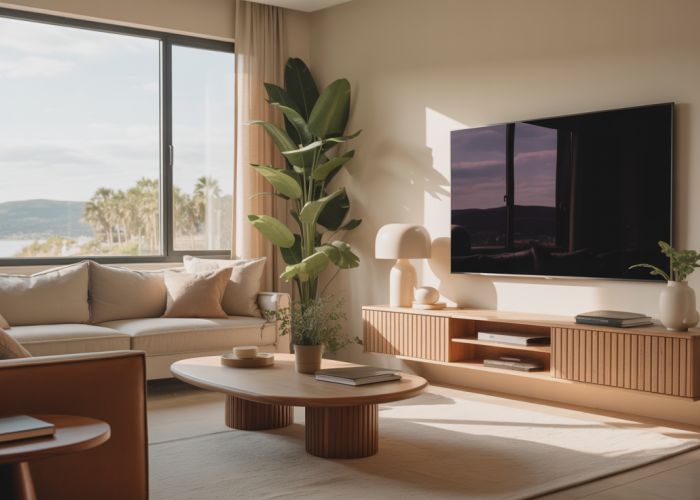Achieving optimal viewing pleasure is crucial, and this starts with understanding eye level tv. The Society of Motion Picture and Television Engineers (SMPTE) recommends specific guidelines for screen placement. Correct viewing angles impact not only comfort but also potential strain, making considerations like TV stand height vital. This guide will navigate you through understanding eye level tv so that you can achieve the best viewing experience at home.

Achieving Perfect Viewing: Your Eye Level TV Guide
This guide will walk you through everything you need to know to position your TV at the ideal eye level, maximizing viewing comfort and picture quality. Getting this right can reduce neck strain, improve your visual experience, and even make your room look better!
Understanding Why Eye Level Matters
Before we dive into the specifics, let’s understand why proper TV height is so crucial.
- Comfort: Viewing a screen that’s too high or too low can cause neck pain and eye strain, especially during long viewing sessions. Maintaining a natural, relaxed posture is key.
- Picture Quality: Many modern TVs are designed with specific viewing angles in mind. Viewing from an extreme angle (above or below) can distort colors and reduce contrast.
- Aesthetics: A TV mounted or placed at the correct height simply looks better and contributes to a more polished and intentional room design.
Determining Your Ideal Eye Level TV Height
Finding your perfect eye level involves a few key considerations:
Measuring Seating Height
The first step is to determine the height of your eyes when you’re seated in your usual viewing spot.
- Sit in your favorite chair or sofa, where you typically watch TV.
- Have someone measure the distance from the floor to your eyes while you’re sitting in a relaxed, natural position. This is your seated eye height.
Calculating Optimal TV Center Height
The ideal height for the center of your TV screen should be approximately equal to your seated eye height. This doesn’t mean the bottom of your TV should be at this height, but rather the middle of the screen.
To determine the ideal mounting height, you’ll need to factor in the TV’s dimensions.
Factoring in TV Size
TV size directly affects the ideal mounting height. A larger TV will naturally sit higher on the wall, even if the center is at your target eye level.
| TV Screen Size (inches) | Approximate Recommended Mounting Height (Bottom of TV from Floor – assuming a TV stand or similar support) |
|---|---|
| 42" | 22 – 32 inches |
| 55" | 28 – 38 inches |
| 65" | 32 – 42 inches |
| 75" | 36 – 46 inches |
| 85" or larger | 40 – 50 inches (adjust based on specific eye level height) |
Important Note: These are just guidelines. Always prioritize your personal comfort and seated eye height. You may need to adjust slightly based on your specific circumstances.
Methods for Achieving Ideal Eye Level TV Positioning
There are several ways to ensure your TV is at the optimal height:
Wall Mounting
Wall mounting is a popular option that offers a clean, modern look.
- Pros: Saves floor space, adjustable viewing angles (with a tilting mount), hides cables.
- Cons: Requires drilling into the wall, can be difficult to move later.
- Tips: Use a stud finder to locate wall studs for secure mounting. Consider cable management solutions to hide wires within the wall.
Using a TV Stand
TV stands are a traditional and versatile option.
- Pros: Easy to set up, readily movable, offers storage space.
- Cons: Takes up floor space, limited height adjustment.
- Tips: Choose a stand that is appropriately sized for your TV. Ensure the stand is sturdy and stable.
Other Considerations
- Tilting TV Mounts: If your TV is unavoidably positioned slightly above eye level (e.g., mounted above a fireplace), a tilting mount can help compensate by angling the screen downwards.
- Room Layout: The size and shape of your room, as well as the placement of windows and furniture, can influence your optimal TV height.
- Multiple Viewing Positions: If you frequently watch TV from different locations in the room, consider finding a compromise height that works reasonably well for all viewing positions.
By carefully considering these factors and using the guidelines provided, you can achieve the perfect "eye level tv" setup and enjoy a more comfortable and immersive viewing experience.
Eye Level TV: Frequently Asked Questions
Here are some common questions about achieving the perfect eye level TV setup.
Why is eye level important for TV viewing?
Viewing your TV at eye level reduces strain on your neck and eyes. This leads to a more comfortable and immersive viewing experience, especially during long movie nights or gaming sessions. An ideal eye level tv setup is a healthier setup.
How do I determine the correct height for my TV?
First, measure the height from the floor to your eye level when seated on your usual viewing chair or sofa. Then, adjust your TV’s mounting height so that the center of the screen is approximately at that eye level.
What if I can’t mount my TV at the exact eye level?
If precise eye level tv mounting isn’t possible, aim to be as close as you can. A slightly lower position is generally preferable to a higher one, as looking upwards can strain your neck more quickly.
Can I use a TV stand instead of mounting?
Yes! TV stands are a great option. Choose a stand that places your TV at the correct height for comfortable viewing, remembering to consider your seated eye level.
So, ready to ditch the neck craning and enjoy your favorite shows? Hopefully, this guide helps you find your sweet spot for eye level tv. Happy watching!